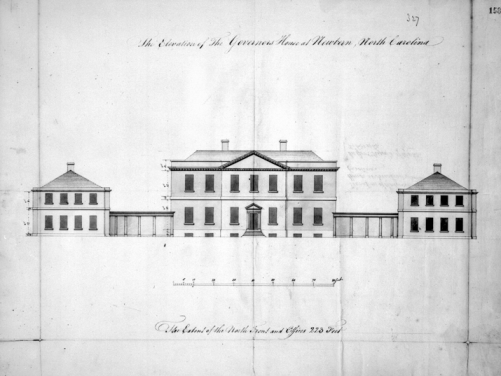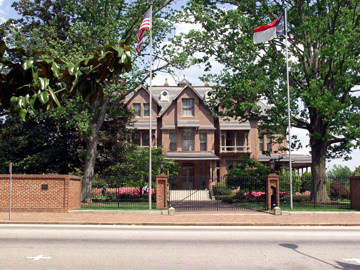See also: Raleigh; State Capitol.

Several locations served as the seat of government for the colony and state of North Carolina before Raleigh was designated as its permanent capital. For most of the colonial period, the capital was situated in whatever town the governor lived. The colony's records, stored at different locations, were carted from place to place, often suffering loss and damage in the process.
From April 1692 to March 1712, North Carolina and South Carolina were combined into the single province of Carolina, of which Charles Towne (Charleston, S.C.) served as the official seat of government. In subsequent years, sharp competition between different regions of North Carolina made it difficult to agree on the site for a permanent capital. The Assembly had no fixed location for most of the colonial period; only fragmentary records remain of the sessions of the seventeenth and much of the early eighteenth century. The legislature met in Edenton in 1708. Before and for a few years after that date, it evidently met in various private homes and public buildings in the colony. For example, the Executive Council called for the Assembly of 1715-16 to meet at the home of Capt. Richard Sanderson in Little River, "instead of the Church in Chowan which was the place of ye last meeting."
From 1725 to 1736 the Assembly again met at Edenton. Later sessions were held there, as well as at New Bern, Wilmington, and Bath. In 1746 the legislature passed an act to make New Bern the permanent capital. The measure was vetoed by the royal government, partly because of objections from the northern counties. The Assembly in 1758 located the capital at Tower Hill, a place on the Neuse River near modern Kinston, where a new town, to be called George City, was to be built. The plan stalled and was dropped. New Bern at last was made the permanent capital in 1766, when the Assembly voted to build what came to be known as Tryon Palace, colonial governor William Tryon's mansion.
After the American Revolution began, the seat of government was considered to be wherever the legislature met. Before an Assembly for the rebels was organized, the Provincial Council met at the "court house in Johnston County" in 1775-76. In 1776 the Council of Safety met at Wilmington, "William Whitfield's in Dobbs County," "Joel Lane's in Wake County," Salisbury, and Halifax (twice). During 1774-76 the Provincial Congress of North Carolina met twice in New Bern, once in Hillsborough, and twice in Halifax.

The General Assembly of 1777 met in New Bern; during 1778-81, it convened in New Bern, Hillsborough, Halifax, Smithfield, and Wake Court House. In 1781 officials chose Hillsborough as the permanent capital. When the town was raided later that year by Loyalist forces under David Fanning, the legislature determined that it was not a safe location for a capital. After the Revolution, the General Assembly continued to move, holding sessions at Hillsborough, New Bern, Fayetteville, and Tarboro.
In 1788 the lawmakers decided to resolve the issue of a permanent state capital once and for all. At a convention in Hillsborough to consider ratification of the U.S. Constitution that summer (the measure would fail), they created a committee, led by Willie Jones, to fix an "unalterable seat of government of this state" within ten miles of Isaac Hunter's plantation in Wake County. Willie Jones and the committee favored this location but left the choice of a particular site to the legislature. Advocates of Fayetteville as the capital kept the issue alive by delay tactics. When the proposal came to a vote on 29 Mar. 1790, the House and Senate split evenly, with the House Speaker voting for Wake County and the Senate Speaker in opposition. On 5 December the legislature finally approved the Wake County site and appointed a nine-member commission to purchase a tract of land. After visiting more than a dozen farms, the commissioners continued to put off a decision. Joel Lane, however, gave a lavish dinner for them, and his property soon was chosen. Most historians credit Governor Alexander Martin with suggesting that the site be named to honor Sir Walter Raleigh, the leader of England's early colonization efforts. The General Assembly met in Raleigh for the first time during 1794-95 and a capitol building was finished in 1796. As a state law required the governor to live in Raleigh, a house for the chief executive was provided by 1797.